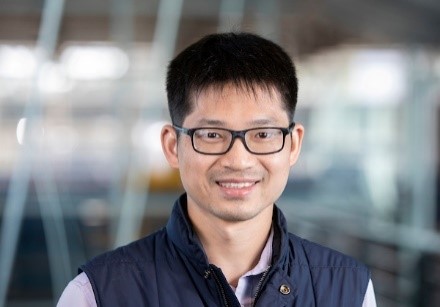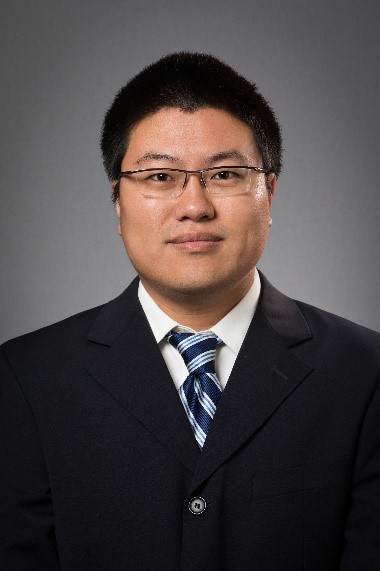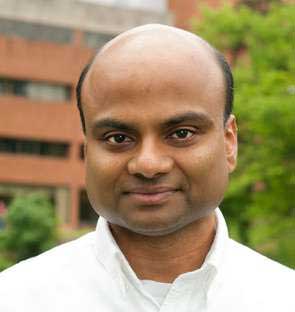Utilizing Innovative Materials Science Approaches to Enhance Bioremediation: Session II - Chlorinated Compounds
Sponsored by: NIEHS Superfund Research Program
The NIEHS Superfund Research Program (SRP) is hosting a Progress in Research webinar series to showcase new breakthroughs to advance sustainable solutions for hazardous substances in the environment. The three-part series will feature SRP individual research projects funded in 2020, who are incorporating new advances in materials science to optimize bioremediation of contaminants in soil, sediment, or water. In each session, awardees will describe their research projects, accomplishments, and next steps.
The second session will showcase novel tools and improved techniques to clean up sites contaminated with chlorinated compounds.
Florida State University researchers are designing sorbents to clean up groundwater contaminated with 1,4-dioxane and chlorinated volatile organic contaminants (VOCs). Consisting of a set of repeating cyclic macromolecules with unique geometry and internal chemistry, the sorbents can form specific microbe-contaminant complexes with only selected molecules, such as 1,4-dioxane.
At Oregon State University, investigators are developing a strategy to use bacteria encapsulated with a slow-release compound in hydrogel beads to break down complex mixtures of contaminants, such as VOCs and 1,4-dioxane. Using materials science and laboratory studies, the team aims inform long-term bioremediation solutions to treat a broad range of contaminants.
Researchers at the University of Iowa are investigating how activated carbon can be used to enhance the performance of bacteria used to break down halogenated pollutants, such as chlorinated ethenes. By re-engineering carbon materials, they hope to influence the composition of the degrading microbial community and increase their ability to break down mixtures of halogenated contaminants.
A team at the University of Maryland, Baltimore County is developing carbon-based sorbent materials to enhance the ability of bacteria to break down mixtures of chlorinated organic contaminants, such as chloroethene and polychlorinated biphenyls, in groundwater and sediments. They hope to integrate their laboratory findings with advanced site models to assess field-scale remedial applications.
Accessibility, Recording, and Content Disclaimer
Rehabilitation Act Notice for Reasonable Accommodation
It is EPA's policy to make reasonable accommodation to persons with disabilities wishing to participate in the agency's programs and activities, pursuant to the Rehabilitation Act of 1973, 29 U.S.C. 791. Any request for accommodation should be made to at or , preferably one week or more in advance of the webinar, so that EPA will have sufficient time to process the request. EPA would welcome specific recommendations from requestors specifying the nature or type of accommodation needed. Please note that CLU-IN provides both alternate phone call-in options and closed captioning for all webinars, and requests for these specific accommodations are not necessary.
Webinar Recording
By participating in this CLU-IN webinar, you automatically agree to authorize recording of audio and visual content presented during this live event and consent to subsequent use of this recording in the public domain by the U.S. Environmental Protection Agency. This recording may include questions, comments and poll responses provided by you during the live event in addition to your name, voice, image or likeness. This recording will be made available after the conclusion of the live event as part of the CLU-IN webinar archives, and will remain available indefinitely. If you do not wish to consent to the recording, please do not join the live event, and contact Jean Balent at 202-566-0832 or balent.jean@epa.gov to discuss your concerns.
Content Disclaimer
This webinar is intended solely to provide information to the public. The views and opinions expressed as part of this webinar do not necessarily state or reflect those of the U.S. Environmental Protection Agency. It is not intended, nor can it be relied upon, to create any rights enforceable by any party in litigation with the United States, or to endorse the use of products or services provided by specific vendors. With respect to this webinar, neither the United States Government nor any of their employees, makes any warranty, express or implied, including the warranties of merchantability and fitness for a particular purpose, or assumes any legal liability or responsibility for the accuracy, completeness, or usefulness of any information, apparatus, product, or process disclosed, or represents that its use would not infringe privately owned rights.
Presenters:
 Youneng Tang, Ph.D., Florida State University (ytang@eng.famu.fsu.edu)
Youneng Tang, Ph.D., Florida State University (ytang@eng.famu.fsu.edu)
Youneng Tang, Ph.D., is an associate professor in the Department of Civil and Environmental Engineering in the College of Engineering at Florida State University. He received a doctoral degree in Environmental Engineering from Arizona State University. Tang's group studies biofilm processes during in-situ bioremediation of contaminated groundwater and ex-situ treatment of water. The contaminants that his group are currently researching include chlorinated organic compounds, 1,4-dioxane, per- and polyfluorinated substances (PFAS), and some metals.
 Yuexiao Shen, Ph.D., Texas Tech University (yuexiao.shen@ttu.edu)
Yuexiao Shen, Ph.D., Texas Tech University (yuexiao.shen@ttu.edu)
Yuexiao Shen, Ph.D., is an assistant professor in the Department of Civil, Environmental and Construction Engineering at Texas Tech University. He received his Ph.D. degree in Chemical Engineering from Penn State University. His group is developing highly selective materials for environmental remediation including chlorinated organic compounds, 1,4-dioxane, and PFAS. Dr. Shen is also interested in innovative materials for critical mineral recovery from brine and e-waste.
 Lewis Semprini, Ph.D., Oregon State University (lewis.semprini@oregonstate.edu)
Lewis Semprini, Ph.D., Oregon State University (lewis.semprini@oregonstate.edu)
Lewis Sempini, Ph.D., studies biological processes for the treatment of hazardous wastes, and on the fate and transport of organic contaminants in the environment. He specializes in field, laboratory, and modeling studies of both aerobic and anaerobic processes for treating chlorinated solvents and emerging contaminants. His research efforts over the past 30 years have aimed at integrating the results of field, laboratory, and modeling studies to effectively apply bioremediation technologies for the cleanup of contaminated sites.
 Tim Mattes, Ph.D., University of Iowa (tim-mattes@uiowa.edu)
Tim Mattes, Ph.D., University of Iowa (tim-mattes@uiowa.edu)
Timothy (Tim) Mattes, Ph.D., has been a professor in the Department of Civil and Environmental Engineering at the University of Iowa since 2004. His research and teaching expertise focus in the areas of environmental microbiology, environmental biotechnology, bioremediation and environmental engineering. His major research interests include application of microbiology and molecular microbial ecology techniques to understand the roles of microorganisms in biodegradation of hazardous compounds in the environment, such as chlorinated ethenes, polychlorinated biphenyls, 1,4-dioxane and explosives. Dr. Mattes received a Ph.D. in Civil and Environmental Engineering from Cornell University.
 Wenqing Xu, Ph.D., Villanova University (wenqing.xu@villanova.edu)
Wenqing Xu, Ph.D., Villanova University (wenqing.xu@villanova.edu)
Wenqing Xu, Ph.D., is currently an associate professor in the Department of Civil and Environmental Engineering at Villanova University. The central focus of her research program is to better understand the various ways that nature detoxifies contaminants by the integration of chemical, biological, and material sciences approaches to attenuate pollutant transport and thereby protect source water and degrade contaminants with novel materials to provide safe drinking water. Dr. Xu has served as a principal and co-principal investigator of projects funded by the Strategic Environmental Research and Development Program, the National Science Foundation (NSF), the National Institute of Environmental Health Sciences, and the Environmental Protection Agency on research involving the development of reactive adsorbents for pollutant abatement, such as chlorinated solvents, pesticides, munitions constituents, PFAS and disinfection byproducts. She is a recipient of various awards, including the NSF CAREER award (2018) and the University Scholarly Achievement Award (2020).
 Upal Ghosh, Ph.D., Department of Chemical, Biochemical, and Environmental Engineering at the University of Maryland Baltimore County (ughosh@umbc.edu or 410-455-8665)
Upal Ghosh, Ph.D., Department of Chemical, Biochemical, and Environmental Engineering at the University of Maryland Baltimore County (ughosh@umbc.edu or 410-455-8665)
Upal Ghosh Ph.D., is a professor in the department of Chemical, Biochemical, and Environmental Engineering at the University of Maryland Baltimore County. He has a B. Tech in Chemical Engineering from the Indian Institute of Technology, Bombay, India, an M.S. and Ph.D. in Civil and Environmental Engineering from the State University of New York at Buffalo and completed a Postdoc at Carnegie Mellon University and worked as a Research Associate at Stanford University. He is currently the Principal investigator for the Development of in-situ Mercury Remediation Approaches Based on Methylmercury Bioavailability NIEHS R01 grant and recently completed and NIEHS R01 grant titled Combining Bioavailability Assays with Modeling to Predict PCBs in Fish after Remediation. His group performs research in environmental engineering and science with a focus on the fate, effects, and remediation of toxic pollutants in the environment. They use multidisciplinary tools to investigate exposure and bioavailability of organic and metal contaminants to organisms and this new understanding is used to develop novel remediation technologies and site-specific remediation goals. Recent projects have focused on contaminants such as PCBs, PAHs, pesticides, dioxins, and mercury. For more information please refer to Dr. Ghosh's faculty profile.
Moderators:
 Cindy Frickle, U.S. EPA Office of Superfund Remediation and Technology Innovation (frickle.cynthia@epa.gov or 202-566-0927)
Cindy Frickle, U.S. EPA Office of Superfund Remediation and Technology Innovation (frickle.cynthia@epa.gov or 202-566-0927)
Cindy Frickle is a physical scientist with EPA's Superfund program where she reviews and propagates technical information to site cleanup professionals through Clu-In, EPA forums, and interagency channels. Prior to joining EPA, she spent time characterizing contaminated sites, coring sediments, studying microbes, and teaching. She completed her Biogeology MS and Geology BS in the University of Minnesota's School of Earth Sciences.
 Jean Balent, U.S. EPA Technology Innovation and Field Services Division (balent.jean@epa.gov or 202-566-0832)
Jean Balent, U.S. EPA Technology Innovation and Field Services Division (balent.jean@epa.gov or 202-566-0832)
Ms Balent is on the staff of the EPA's Technology Innovation and Field Services Division where she has worked to collect and disseminate hazardous waste remediation and characterization information since 2003. Ms Balent manages the Clean Up Information Network website and actively supports online communication and collaboration resources available to EPA. She formerly worked with the US Army Corps of Engineers Environmental Engineering Division in the Buffalo District. Ms Balent was also a member of the SUNY-Buffalo Groundwater Research Group where she constructed and tested large scale models of groundwater flow. Ms Balent has also conducted research relating to the Great Lakes, environmental remediation, and brownfields re-development. She holds a Bachelor's degree in environmental engineering from SUNY-Buffalo and a Master's degree in Information Technology from AIU.
Webinar Slides and References:
Webinar Slides and References:
-
 Slide Presentation for Youneng Tang, Ph.D., and Yuexiao Shen, Ph.D. (1.65MB/PDF)
Slide Presentation for Youneng Tang, Ph.D., and Yuexiao Shen, Ph.D. (1.65MB/PDF)
-
 Slide Presentation for Lewis Semprini, Ph.D (2.47MB/PDF)
Slide Presentation for Lewis Semprini, Ph.D (2.47MB/PDF)
-
 Slide Presentation for Tim Mattes, Ph.D., and Wenqing Xu, Ph.D (1.76MB/PDF)
Slide Presentation for Tim Mattes, Ph.D., and Wenqing Xu, Ph.D (1.76MB/PDF)
-
 Slide Presentation for Upal Ghosh, Ph.D. (792KB/PDF)
Slide Presentation for Upal Ghosh, Ph.D. (792KB/PDF)
Additional Resources:
- For an overview of this webinar series, see the SRP Progress in Research webpage
- SRP Individual Research Projects (R01) grantees fact sheet
Thank you for participating in our webinar. We would like to receive any feedback you might have that would make this service more valuable.
Help & FAQs
Zoom Resources
This seminar will be delivered through Zoom. Participants are encouraged to update to the latest version of the Zoom application for the best experience. If you are unable to install the Zoom application, most functions will be available if you join just using a modern web browser such as Chrome, Edge or Firefox. We strongly encourage you to run the Zoom Meeting Test prior to attending this seminar. Technical support on the day of the seminar will be very limited and subject to significant delays.
Rehabilitation Act Notice for Reasonable Accommodation
It is EPA's policy to make reasonable accommodation to persons with disabilities wishing to participate in the agency's programs and activities, pursuant to the Rehabilitation Act of 1973, 29 U.S.C. 791. Any request for accommodation should be made to at or , preferably one week or more in advance of the seminar, so that EPA will have sufficient time to process the request. EPA would welcome specific recommendations from requestors specifying the nature or type of accommodation needed, such as closed captioning.
with any additional questions
If you have a suggested topic or idea for a future CLU-IN internet seminar, please contact:
Technology Integration and Information Branch
PH: 202-566-0832 | Email: balent.jean@epa.gov
Technology Integration and Information Branch
PH: 202-566-0875 | Email: adam.michael@epa.gov





